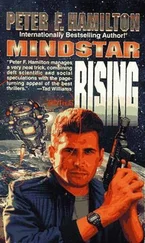“Good enough,” Admiral Farquar said.
“I’ll put the marines at Sapcoat base on active status as of now,” Deborah said. “That’s over a hundred kilometres from Atherstone. The plane can reach it easily enough.”
“A hundred kilometres is a safe enough distance,” Ryle Thorne said smoothly.
Ralph didn’t like the minister’s attitude; he seemed to be treating this as if it were a minor natural incident, like a hurricane or earthquake. But then the minister had to go back to his constituents every five years and convince them he was acting in their best interests. Ordering SD platforms to fire on their fellow citizens might be hard to explain away in public relations terms. That was one of the reasons the royal Saldanas had a parliament to advise them. An insulating layer around the blame. Elected politicians were always culpable and replaceable.
“I’d also suggest that once the plane’s landed you use an orbital sensor satellite to mount a permanent observation on it,” Ralph said. “Just in case there’s any attempt to break out. That way we can use the SD platforms as a last resort; sterilize the entire area.”
“That strikes me as somewhat excessive,” Ryle Thorne said with elaborate politeness.
“Again, no, sir. On Lalonde the enemy were able to use their electronic warfare capability to interfere with the LDC’s observation satellite from the ground; they fuzzed the images to quite a degree. I’d say this fallback option is the least we should be doing.”
“Ralph was brought in because of his experience in combating the virus,” Roche Skark said, smiling at the minister. “He got off Lalonde precisely because he instigated these kinds of protective measures.”
Ryle Thorne gave a short nod.
“Pity he didn’t protect us from the virus,” Jannike muttered. Except in a sensenviron context nothing was really sotto voce; all utterances were deliberate.
Ralph glanced over at her, but the computer-synthesised image of her face gave nothing away.
Chapman Adkinson was getting mighty tired of the continual stream of datavises he was receiving from flight control. Worried, too. He wasn’t dealing with civil flight control at Atherstone anymore; they’d gone off-line eight minutes ago. Military protocols were being enforced now, the whole planet’s traffic control being routed through the Royal Navy operations centre on Guyana. And they were none too sympathetic to his condition.
Esparta was rolling by below the plane, one of the lush national parks which surrounded the capital. A jungle scarred only by the occasional Roman-straight motorway and dachas belonging to the aristocracy. The ocean was five minutes behind them.
His neural nanonics were accessing the external sensors, but the visual image was only being analysed in secondary mode, mainly to back up the inertial guidance system which he no longer wholly trusted. He was concentrating on schematics of the plane’s systems. Twenty per cent of the onboard processors were suffering from random dropouts. Some had come back on-line after a few seconds, others remained dead. The diagnostic programs he ran simply couldn’t pinpoint the problem. And, even more disturbing, in the last fifteen minutes he’d been experiencing spikes and reductions in the power circuits.
That was what had made him argue with the military controllers. Processor glitches were an acceptable menace; there was so much redundancy built into the plane’s electronic architecture it could survive an almost total shutdown; but power loss was in a different hazard category altogether. Chapman Adkinson had already decided that if they did try to force him to fly back over the ocean he was going to ditch there and then, and to hell with the penalties they’d load into his licence. The biohazard in Xingu couldn’t be that lethal, surely?
“Chapman, stand by for some updated landing coordinates,” Guyana’s flight controller datavised. “We’re diverting you.”
“Where to?” Chapman asked sceptically.
“Sapcoat base. They’re prepping a clean reception area for you. Looks like the passengers are going to have to stay on board for a while once you’re down.”
“As long as we get down.”
The coordinates came through, and Chapman fed them directly into the flight computer. Twelve minutes to Sapcoat. He could accept that. The plane banked gently to port, and began to curve away from the city which lay somewhere beyond the horizon’s black and silver heat shimmer.
It was a signal for the glitches to quadruple. Circuits began to drop out at a frightening rate. A quarter of the system’s schematics flicked to a daunting black, leaving only ghostly colourless outlines where functional hardware had been a moment before. Power to the two rear starboard compressors failed completely. He could hear the high-pitched background whine deepening as the blades slowed. The flight computer’s compensation program went primary, but too many control surfaces had shut down for it to be truly effective.
“Mayday, mayday,” Chapman datavised. Even his primary transmitter had failed. Backup processors were activated. The fuselage began to vibrate and judder, as if the plane were ploughing through a patch of choppy air.
His neural nanonics reported a stream of datavises from the passenger cabin, querying the shaking and sudden loss of in-flight entertainment processors. He called up a procedural file and shunted it into what was left of the plane’s entertainment circuits. Seatback holoscreens should be playing a placebo message about clear air turbulence and the precautions their pilot was now instigating.
“What is it?” flight control asked.
“Losing power and height. Systems failure rate increasing. Shit! I just lost the tail rudder databus.” He datavised an emergency code into the flight computer. A silvery piston slid out of the horseshoe console in front of him, a dull chrome-red pistol grip on the end. It reached his lap and rotated silently through ninety degrees. Chapman grabbed it. Manual control. Christ, I’ve never used one outside of Aviation Authority simulations!
The datavise bandwidth to the flight computer started to shrink. He prioritized the schematic to display absolute essentials. Holographic displays on the console came alive, duplicating the information.
“Find me a flat patch of land, now, damn it!” How he was going to bring the plane down in VTOL configuration with both the starboard compressors out wasn’t something he wanted to think about. Maybe a motorway, and use it like a runway?
“Request denied.”
“What?”
“You may not land anywhere but the authorized coordinate.”
“Fuck you! We’re going to crash.”
“Sorry, Chapman, you cannot land anywhere outside Sapcoat.”
“I can’t reach Sapcoat.” His datavised control linkage to the flight computer began to fail. The pistol grip shifted slightly in his hand, and he felt the plane tilt in tandem.
Careful! he told himself. A firm pressure on the grip, and the nose began to edge back. The holographic horizon graphic showed he was still in a shallow dive. More pressure, and the descent rate slowed.
The door into the cockpit slid open. Chapman Adkinson was wired too tight to care. It was supposed to be codelocked, but the way hardware was crashing . . .
“Why have you altered course?”
Chapman shot a quick glance over his shoulder. The guy was dressed in a cheap suit, five years out-of-date. He wasn’t just calm, he was serene. Incredible! He must feel the plane’s buffeting.
“Technical problem,” Chapman managed to gasp. “We’re putting down at the nearest landing pad that can handle an emergency.” The pistol grip was fighting his every movement. And now the holographic displays were wobbling. He wasn’t sure if he could trust them anymore. “Get back into your seat now, fella.”
Читать дальше












